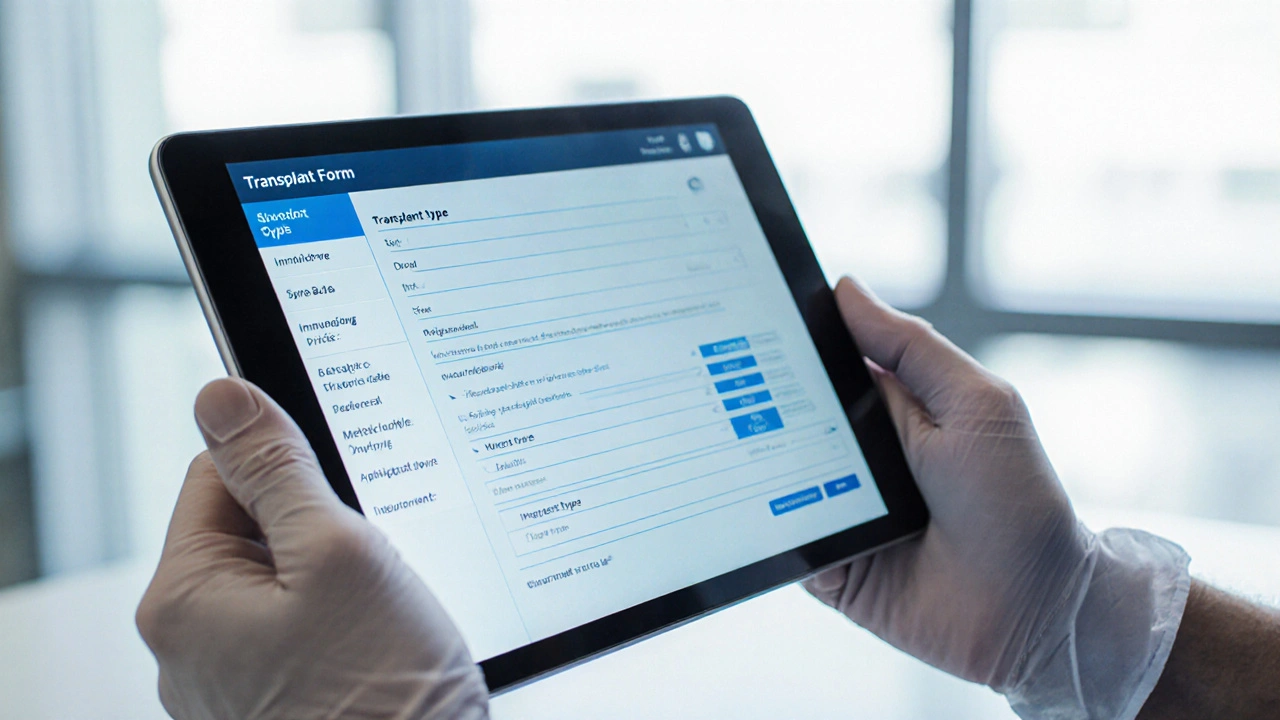Prograf vs Alternatives: Drug Selection Tool
Enter patient details and click "Recommend Drug Regimen" to see personalized recommendations.
Prograf (Tacrolimus)
- Nephrotoxicity
- Neurotoxicity (tremor, headache)
- Diabetes
- Hypertension
- Hyperlipidemia
Monthly Cost: $600-$900
Alternatives
- Cyclosporine - Nephrotoxicity, Hirsutism
- Sirolimus - Hyperlipidemia, Delayed Wound Healing
- Everolimus - Stomatitis, Interstitial Lung Disease
- MMF - GI Upset, Leukopenia
- Belatacept - Higher Acute Rejection, PTLD Risk
Key Takeaways
- Prograf (tacrolimus) is a calcineurin inhibitor widely used for organ‑transplant maintenance.
- Its main competitors are cyclosporine, sirolimus, everolimus, mycophenolate mofetil (MMF) and belatacept.
- When choosing a regimen, weigh efficacy, side‑effect profile, dosing convenience, drug interactions and cost.
- Therapeutic drug monitoring (TDM) is crucial for tacrolimus, while some alternatives need different labs.
- A quick‑reference checklist at the end helps clinicians match patient needs to the right drug.
What Is Prograf (Tacrolimus)?
Prograf is a potent immunosuppressant that belongs to the calcineurin‑inhibitor class. It blocks T‑cell activation by preventing the phosphatase activity of calcineurin, which stops interleukin‑2 transcription. First approved in 1994, it quickly became the backbone of most kidney, liver and heart transplant protocols because it offers stronger potency and a slightly better side‑effect profile than older drugs.
Typical oral dosing ranges from 0.1 to 0.3mg/kg per day, divided into two doses for most transplant types, though once‑daily formulations (e.g., Advagraf) are now common. The drug is metabolized by CYP3A4 and P‑glycoprotein transporters, making it sensitive to many drug‑drug interactions.
Why Compare? The Need for Alternatives
No single drug fits every patient. Some people develop nephrotoxicity, neurotoxicity or metabolic problems on tacrolimus. Others need a regimen that avoids CYP3A4 interactions, such as with certain antifungals or antiretrovirals. Insurance formularies and out‑of‑pocket costs also push clinicians to consider alternatives. Understanding how each option stacks up lets you tailor therapy to the individual’s medical history, lifestyle and financial situation.
Overview of Common Alternatives
Below is a snapshot of the five most frequently used alternatives. Each entry includes the drug’s class, how it works, typical transplant applications, and a few key attributes.
- Cyclosporine - another calcineurin inhibitor, older than tacrolimus, often used when tacrolimus is not tolerated.
- Sirolimus - an mTOR inhibitor that blocks T‑cell proliferation downstream of IL‑2 signaling.
- Everolimus - a newer mTOR inhibitor with a shorter half‑life, frequently paired with reduced tacrolimus doses.
- Mycophenolate mofetil (MMF) - an antimetabolite that inhibits guanine nucleotide synthesis, used in combination with calcineurin inhibitors.
- Belatacept - a costimulation blocker (CTLA‑4 Ig) that interferes with the CD28‑CD80/86 pathway, approved for kidney transplantation.

Side‑Effect Landscape
Side effects drive many drug switches. Below each drug’s most common adverse events are listed in order of clinical relevance.
- Prograf: nephrotoxicity, neurotoxicity (tremor, headache), diabetes, hypertension, hyperlipidemia.
- Cyclosporine: nephrotoxicity, hirsutism, gingival hyperplasia, hyperlipidemia, hypertension.
- Sirolimus: hyperlipidemia, delayed wound healing, mouth ulcers, anemia, proteinuria.
- Everolimus: similar to sirolimus but higher incidence of stomatitis and interstitial lung disease.
- MMF: gastrointestinal upset, leukopenia, anemia, increased infection risk.
- Belatacept: higher acute‑rejection rates in early post‑transplant period, increased risk of PTLD (post‑transplant lymphoproliferative disorder) especially in EBV‑negative patients.
Cost Considerations (2025 US Estimates)
Insurance coverage varies, but here are average wholesale price (AWP) ranges for a standard adult regimen.
| Drug | Mechanism | Typical Indication | Monthly Cost (USD) | Key Side Effects |
|---|---|---|---|---|
| Prograf | Calcineurin inhibition | Kidney, liver, heart | $600‑$900 | Nephrotoxicity, diabetes |
| Cyclosporine | Calcineurin inhibition | Kidney, liver | $400‑$650 | Nephrotoxicity, hirsutism |
| Sirolimus | mTOR inhibition | Kidney, heart, liver (off‑label) | $800‑$1,200 | Hyperlipidemia, wound healing |
| Everolimus | mTOR inhibition | Kidney (with reduced tacrolimus) | $900‑$1,300 | Stomatitis, lung toxicity |
| Mycophenolate mofetil (MMF) | Antimetabolite | Kidney, heart, liver (combo) | $350‑$550 | GI upset, leukopenia |
| Belatacept | Co‑stimulation blocker | Kidney (de‑novo) | $2,100‑$2,800 (infusion) | PTLD, higher early rejection |
Choosing the Right Agent: Decision Framework
Use the following criteria checklist to narrow down the best option for a given patient.
- Efficacy Needs: Does the patient have a high immunologic risk (e.g., PRA > 20%)? High‑risk patients often benefit from the strong potency of tacrolimus or a combination with MMF.
- Renal Function: Baseline eGFR < 30mL/min/1.73m²? Consider minimizing calcineurin exposure (switch to belatacept or low‑dose tacrolimus + mTOR).
- Metabolic Profile: History of diabetes or dyslipidemia? Sirolimus/everolimus worsen lipids, while tacrolimus can trigger new‑onset diabetes. MMF is metabolically neutral.
- Drug Interactions: Taking strong CYP3A4 inhibitors (e.g., ketoconazole) or inducers (e.g., rifampin)? Cyclosporine shares the same pathway, so an alternative like belatacept (IV) may be safer.
- Adherence: Ability to take multiple pills daily? Once‑daily tacrolimus or monthly belatacept infusions improve adherence.
- Cost/Insurance: Verify formulary status. If tacrolimus is not covered, cyclosporine or MMF may be the fallback.
- Side‑Effect Tolerance: Prior history of neurotoxicity (tremor) suggests avoiding tacrolimus; consider cyclosporine or an mTOR inhibitor.
Applying this matrix often leads to a personalized combo: for example, a patient with good renal function but poor adherence might stay on once‑daily tacrolimus plus low‑dose MMF, while a diabetic patient with borderline kidney function could shift to belatacept + MMF.
Monitoring and Practical Management
Each drug demands specific labs and follow‑up intervals.
- Prograf (Tacrolimus): Target trough 5‑15ng/mL (kidney) or 3‑7ng/mL (liver). Check levels twice weekly during the first month, then weekly to monthly. Monitor serum creatinine, fasting glucose, lipids, and blood pressure.
- Cyclosporine: Target trough 150‑300ng/mL. Levels checked weekly initially, then monthly. Watch for serum creatinine spikes and magnesium.
- Sirolimus / Everolimus: Target trough 5‑15ng/mL (sirolimus) or 3‑8ng/mL (everolimus). Lipid panel every 3months; assess wound healing after surgery.
- MMF: No routine therapeutic monitoring, but CBC weekly for the first month, then biweekly. Look for leukopenia < 3,000cells/µL.
- Belatacept: Infusion schedule (weekly for 1month, then biweekly, then monthly). Monitor EBV serology, renal function, and signs of PTLD.
Quick Reference Checklist
- Identify transplant type and immunologic risk.
- Assess baseline renal function and metabolic comorbidities.
- Review current medication list for CYP3A4 interactions.
- Confirm insurance coverage and out‑of‑pocket budget.
- Pick primary agent (tacrolimus vs alternative) based on the decision framework.
- Set up initial labs: drug trough, creatinine, glucose, lipids, CBC.
- Schedule monitoring frequency per chosen drug.
- Document side‑effect mitigation plan (e.g., antihypertensives, statins).

Frequently Asked Questions
How soon after transplant should tacrolimus levels be at target?
Most centers aim for the target trough within the first 3‑5days post‑surgery. Early therapeutic drug monitoring (TDM) is critical to avoid acute rejection while limiting nephrotoxicity.
Can I switch from tacrolimus to cyclosporine without risking rejection?
Switches are possible but should be done gradually, overlapping the two drugs for 4‑7days while monitoring trough levels of both. High‑risk patients need closer surveillance, often with a biopsy schedule.
Is belatacept suitable for non‑kidney transplants?
Belatacept is FDA‑approved only for kidney transplantation. Off‑label use in liver or heart transplants is rare and generally discouraged due to limited data.
Why do some patients develop tremor on tacrolimus?
Tacrolimus can cross the blood‑brain barrier and affect neuronal calcium channels, leading to fine tremor. Dose reduction, switching to cyclosporine, or adding a beta‑blocker often helps.
How does the cost of everolimus compare to tacrolimus in the US?
Everolimus is typically 30‑40% more expensive per month than tacrolimus, especially when combined with a reduced tacrolimus dose. Insurance coverage varies, so a formulary check is essential.
Can MMF replace tacrolimus entirely?
Monotherapy with MMF is not effective for most solid‑organ transplants. It is used as an adjunct to reduce calcineurin‑inhibitor exposure, not as a stand‑alone agent.
By weighing efficacy, safety, convenience and cost, clinicians can pick the most suitable immunosuppressant regimen for each transplant patient. Whether you stay with Prograf or move to an alternative, consistent monitoring and patient education remain the backbone of long‑term graft survival.


johnson mose
October 3, 2025 AT 02:23Whoa, diving into the world of tacrolimus feels like opening a Pandora's box of options-each alternative shimmering with its own quirks and charms. The guide paints a vivid tapestry where nephrotoxicity and neurotoxicity dance side‑by‑side with cost and convenience, forcing clinicians to become modern alchemists. Imagine a kidney transplant patient, balancing on the razor‑edge of diabetes risk, staring at a price tag that could fund a modest vacation. Suddenly, belatacept whispers promises of renal preservation, yet lurks with a specter of PTLD for the unlucky EBV‑negative. Meanwhile, cyclosporine offers a nostalgic nod to the past, with hirsutism sprouting like an unexpected side‑effect garden. And let’s not forget the mTOR crowd-sirolimus and everolimus-playing the lipid‑raising violin in a symphony of delayed wound healing. All this information, wrapped in a sleek interactive tool, turns what could be a bewildering maze into a navigable road map. The key takeaway? No one‑size‑fits‑all; the art lies in matching patient profiles to the perfect pharmacologic puzzle piece.
Charmaine De Castro
October 3, 2025 AT 03:46The side‑effect tables are especially helpful-seeing nephrotoxicity listed next to hyperlipidemia really drives home the trade‑offs you have to juggle.
Mark Mendoza
October 3, 2025 AT 05:26From a philosophical standpoint, each immunosuppressant embodies a different balance of risk and reward-tacrolimus offers potency, but at the cost of metabolic upheaval. 🤔 The decision matrix acts like a moral compass, guiding us through the labyrinth of clinical priorities. 🌿
Dan Tourangeau
October 3, 2025 AT 07:06Agree, the matrix is a solid framework. It’s concise and practical for day‑to‑day rounds.
Bernard Valentinetti
October 3, 2025 AT 08:46Ah-so many variables!!! 🤯 Yet, one must remember the hidden cost of CYP3A4 interactions; they’re like silent ninjas! 🌟
Kenneth Obukwelu
October 3, 2025 AT 10:26In the grand tapestry of transplant immunology, each drug is a cultural ambassador of its own era-tacrolimus heralds the age of calcineurin dominance, while belatacept whispers of a future where co‑stimulation blockade reigns supreme.
Josephine hellen
October 3, 2025 AT 12:06Reading through this guide feels like embarking on an epic journey across a vast, ever‑shifting landscape of pharmacologic possibilities, where each peak represents a different therapeutic summit, and each valley harbors its own lurking perils. The opening paragraph immediately captures the imagination, painting tacrolimus as a potent guardian of transplanted organs, yet also foreshadowing its shadowy side‑effects. As we descend into the discussion of alternatives, the narrative unfurls like a detailed map, guiding us through the intricate alleys of cyclosporine, sirolimus, everolimus, MMF, and belatacept. The cost tables stand out as stark signposts, reminding us that the economics of care can be just as decisive as the pharmacodynamics. One cannot ignore the recurring theme of renal function-how severe impairment nudges clinicians toward belatacept or MMF, striving to preserve the remaining nephron mass. Metabolic comorbidities, such as diabetes and dyslipidemia, emerge as pivotal crossroads, steering the choice toward agents with a more neutral metabolic profile. The interplay of drug‑drug interactions, especially the omnipresent CYP3A4 pathway, adds another layer of complexity that demands meticulous attention. Moreover, the adherence section cleverly acknowledges the human element-once‑daily dosing versus multiple daily pills, infusion schedules, and the psychological burden of chronic therapy. The guide also excels in its practical application, presenting a decision framework that reads like a checklist a seasoned transplant physician would keep at the ready. Each bullet point is an invitation to weigh efficacy, renal function, metabolic status, drug interactions, adherence, cost, and side‑effect tolerance in a systematic fashion. The concluding panels on monitoring underscore the importance of vigilant follow‑up, with specific trough levels and laboratory panels tailored to each drug’s unique profile. In sum, this guide not only educates but also empowers clinicians to craft individualized regimens, marrying science with art, and ultimately enhancing graft survival and patient quality of life.
Ria M
October 3, 2025 AT 13:46Bravo on that odyssey of insight! 🌌 The tapestry you wove showcases the dialectic of survival vs. side‑effects, reminding us that every therapeutic decision is a theatrical act where the patient is both audience and protagonist. 🎭
Michelle Tran
October 3, 2025 AT 15:26Nice summary 🙄
Caleb Ferguson
October 3, 2025 AT 17:06While succinct, the comment captures the essence well; concise feedback is valuable for quick reference.
Delilah Jones
October 3, 2025 AT 18:46The assertive tone about cost considerations hits home-many patients are forced to compromise on the ideal regimen.
Pastor Ken Kook
October 3, 2025 AT 20:26True! 💸 Insurance hurdles can turn a perfect plan into a messy scramble. 😅
Jennifer Harris
October 3, 2025 AT 22:06The guide’s depth is impressive; it serves as a quiet companion for those who prefer reading in solitude.
Northern Lass
October 3, 2025 AT 23:46While the exposition appears exhaustive, one must remain vigilant against the encroaching specter of pharmaceutical hegemony-are we truly choosing the optimal agent, or are we merely capitulating to entrenched industry narratives that masquerade as evidence‑based guidance? The overt emphasis on tacrolimus, despite its well‑documented adverse metabolic profile, may reflect a subtle bias favoring legacy formulations over emergent, albeit less market‑saturated, therapeutics. Moreover, the reliance on cost as a determinative factor, whilst pragmatic, risks reinforcing socioeconomic disparities, whereby patients of limited means are relegated to suboptimal regimens. It is incumbent upon the discerning clinician to interrogate the underlying data, eschew superficial comparatives, and champion an individualized, equity‑focused approach.
Johanna Sinisalo
October 4, 2025 AT 01:26Excellent points raised. Let’s keep the focus on patient‑centered care while navigating these complex considerations.